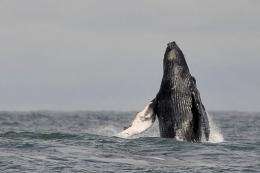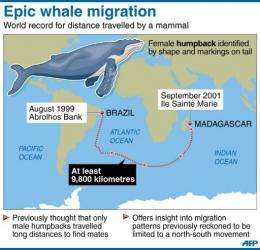Humpback whale beats long-distance record

A humpback whale has broken the world record for travel by any mammal, swimming at least 9,800 kilometres (6,125 miles) from the Atlantic to the Indian Ocean in search of a mate, marine biologists reported on Wednesday.
The female humpback was first photographed among a group of whales at a breeding ground on Abrolhos Bank, off Brazil's southeastern coast, on August 7 1999.
By sheer chance, it was photographed more than two years later, on September 21 2001 by a commercial whale-watching tour at a breeding ground near the Ile Sainte Marie off the eastern coast of Madagascar.
The whale was identified thanks to the distinctive shape of its tail and a pattern of spots on it.
"It is the longest documented movement by a mammal, about 400 kms (250 miles) longer than the longest seasonal migration that has been reported," according to the research, headed by Peter Stevick of the College of the Atlantic in Bar Harbor, Maine.
The trip is not just remarkable for the distance the whale covered, said Stevick.
It also raises exciting questions about the breeding habits of humpbacks (Megaptera novaeangliae), a species of which relatively little is known.
Until now, it was thought that only males, rather than females, would be likely to wander such extreme distances in quest of a partner.
Humpbacks are known to be long-distance swimmers, but until now their migration patterns were thought to be between northern and southerly latitudes.

For instance, a whale might head to feeding area in a far southern latitude in the Atlantic, and then return to a tropical latitude in the Atlantic in order to breed.
But this discovery suggests that humpbacks may also have a migratory pattern that straddles longitudes, not latitudes. In other words, they could swim east-west to breed.
Further work is needed to investigate such theories, as this is just a solitary sighting.
But if more marathon humpbacks are found, it could lead to a rethink of the species' genetic profile, which in turn has an impact on conservation.
So far scientists have been able to identify seven distinct breeding stocks and several sub-stocks of humpbacks in the Southern Hemisphere. Their perceived isolation and entrenched breeding habits raised fears of a restricted gene pool, which is bad news for a species.
Humpbacks were driven close to extinction through over-hunting but are now staging a comeback.
In 2008, the International Union for the Conservation of Union (IUCN) moved humpbacks from the category of Vulnerable to that of Least Concern, meaning it is at low risk of extinction. Two subpopulations remained classified as Endangered, however.
The study appears in Biology Letters, published by Britain's Royal Society.
(c) 2010 AFP



















